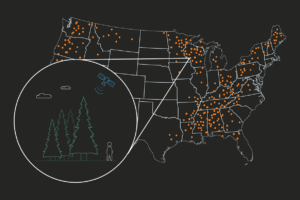This article first appeared in the September 2021 issue of the Forestry Source: Vol. 26 – No 9.
For centuries, maps have been critical to understanding our world. In forestry and natural resource management, this is especially true.
Many efforts have been made to quantify, map, and visualize forests around the globe. Some of these efforts build on advances in remote sensing technologies, using data from sensors to model forest structures and monitor forest change. Other work has focused on using ecological information to model forest characteristics, as well as efforts to harmonize multiple maps of different parts of the globe into single, coherent datasets.
All of these efforts add to our understanding of Earth’s forests and dynamics, as well as how we can use the available tools, data, and technologies to map and estimate the current landscape and predict what changes may come. But, keeping track of all of these projects is challenging.
We’ve compiled a non-exhaustive list of forest map products, along with the inputs and data used to develop the product, resolution of the data product, what value is being mapped (treelists? Aboveground biomass? Cover type?), and what year the dataset represents. More information for each of the datasets we focused on is presented in the table below.
| Dataset | Produced by | Vintage | Resolution | Data Sources used | What is mapped | Applications |
|---|---|---|---|---|---|---|
| Basemap | NCX | 2020 | 30m | Sentinel-2, Landsat, topographic and climate data | treelists | Carbon mapping, forest inventory, habitat mapping |
| Treemap | USFS Firelab | 2014 | 30m | LANDFIRE dataset and other landscape variables (no imagery) | FIA plot IDs – imputed | Fire modelling, carbon mapping, forest inventory |
| BIGMAP | USFS FIA | 2018 | 30m | Remote sensing data and FIA plot data | Inventory characteristics and summarized stocking variables | Carbon mapping, forest inventory |
| GEOCARBON – LUCID data layer | Avitable et al. | 2010 | 1 km | Harmonized two existing pan-tropical and boreal datasets. | AGB | AGB mapping |
| Global Forest Change | Hansen et al. | 2020 | 30m | Landsat | Land use, tree cover, tree cover change | LULC, forest map |
| ESA Global Biomass layers | Santoro, M.; Cartus, O. (2021): ESA Biomass Climate Change Initiative (Biomass_cci): Global datasets of forest above-ground biomass for the years 2010, 2017 and 2018, v2. Centre for Environmental Data Analysis, 17 March 2021. |
mid 1990s, 2007-2010, 2017/2018 and 2018/2019 |
1 km | Sentinel-1, ALOS-1 and ALOS-2, other earth observations | AGB | AGB mapping |
| Forest Carbon Stocks and Fluxes | Williams, C.A., N. Hasler, H. Gu, and Y. Zhou. 2020. Forest Carbon Stocks and Fluxes from the NFCMS, Conterminous USA, 1990-2010. ORNL DAAC, Oak Ridge, Tennessee, USA. |
30m | year 2000 estimates with growth, and change variables | AGB | AGB mapping | |
| Global Aboveground and Belowground Biomass Carbon Density Maps |
Spawn, S.A., and H.K. Gibbs. 2020. Global Aboveground and Belowground Biomass Carbon Density Maps for the Year 2010. ORNL DAAC, Oak Ridge, Tennessee, USA. |
2010 | 300m | synthesized from multiple published sources | AGB | AGB mapping |
| CMS: Forest Carbon Stocks, Emissions, and Net Flux for the Conterminous US: 2005-2010 |
Hagen, S., et al. 2016. CMS: Forest Carbon Stocks, Emissions, and Net Flux for the Conterminous US: 2005-2010. ORNL DAAC, Oak Ridge, Tennessee, USA. | 2010 | 100m | Geoscience Laser Altimeter System data, FIA plot data | AGB | AGB mapping, forest change and carbon flux work |
| GFC30 | Zhang et al 2020 | 2018 | 30m | Landsat 8, DEM, global reference points | Forest cover | LULC |
| ESRI Living Atlas | ESRI, Microsoft, and the Impact Observatory | 2020 | 10m | Sentinel-2 as primary input | Global land cover, including forests | LULC |
| Tree Atlas | Peters, M.P., Prasad, A.M., Matthews, S.N., & Iverson, L.R. 2020. Climate change tree atlas, Version 4. U.S. Forest Service, Northern Research Station and Northern Institute of Applied Climate Science, Delaware, OH. |
Projected to 2100 | 1 degree x 1 degree grid | climate models | potential habitat distributions for 125 tree species | Climate change modelling |
It can be hard to evaluate the accuracy of a dataset representing large-scale, small-area estimates of forest structure or related values, such as aboveground biomass. Data from different researchers and organizations can differ quite substantially – see A Review of Regional and Global Gridded Forest Biomass Datasets for one such assessment. Such differences motivate the creation of harmonized data products like the Avitable et al. work. Another great recent publication focuses on both comparison and validation challenges. The Importance of Consistent Global Forest Aboveground Biomass Product Validation, highlights these challenges, pointing out that there is no canonical or fiduciary dataset representing global biomass field measurements. Many maps and models exist, but independent data to evaluate and compare them is much harder to come by!
Here at NCX, our Data Science team is working on a system for reporting the performance of our Basemap dataset against field data and other available data products. As our programs grow and scale, we are collecting many thousands of field measurements each year – data that we will use to transparently assess our Basemap data product as we improve it over time. In doing so we hope to contribute to the conversation about validation and comparison of these data products as researchers work together to quantify the current state of our forests.



